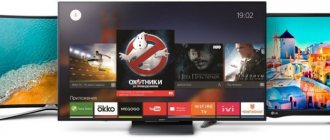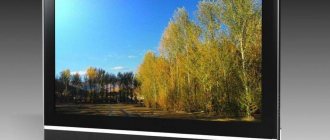| Place | Name | Characteristics in the rating |
| TOP 10 thinnest TVs |
| 1 | Philips 32PHS5583 32″ (2018) | Best price |
| 2 | Samsung UE43TU8000U 43″ (2020) | Simple controls |
| 3 | Samsung T24H390SI 23.6″ (2017) | The best ratio of price and quality |
| 4 | Xiaomi E43S Pro 43″ (2019) | Large amount of built-in memory |
| 5 | Samsung UE43N5570AU 42.5″ (2018) | The most reliable |
| 6 | Sony KD-55XG8577 54.6″ (2019) | Metal frame. Refresh rate 100 Hz |
| 7 | QLED Samsung QE55Q70RAU 55″ (2019) | The most popular |
| 8 | LG NanoCell 55SM8000 55″ (2019) | Bright and realistic picture |
| 9 | Panasonic TX-40GXR700 40″ (2019) | Budget model with 4K |
| 10 | LG OLED65WX9LA 65″ (2019) | The thinnest TV selection |
Thin, light screens with bright and rich colors are now available on almost every TV. But not all models can boast of compact body sizes. We have made for you a selection of popular TVs with the thinnest screens, modern functionality and good image quality.
What are the advantages
The advantages of thin TVs include the thickness of the body and low weight. Thanks to the small values of these parameters, the TV will not take up much space in the room when installed on a stand. In addition, the slim TV can be easily hung on the wall without causing significant impact. In addition to the aesthetic side, these devices are distinguished by display backlight technologies, which, in fact, determines their price.
Thus, LED and OLED backlights are used mainly in budget models, QLED and Nano Cell in the mid-price segment, and SUHD in expensive models. When choosing a TV, this characteristic is one of the main ones.
Sony KD-75XD9405
The third position in our ranking of the thinnest TV models of 2021 is occupied by Sony's flagship product. Your favorite content will become even better, since it is expected to support extended dynamic range - HDR, the picture turns out to be as detailed as possible, with natural color reproduction and contrast, in addition, the brightness range is increased, and all this thanks to HDR and high resolution 4K Ultra HD. Since the TV is premium in terms of image quality, it simply evokes incredible impressions. It has a powerful 4K X1 processor that provides unsurpassed picture quality, and no matter what the content is - DVD, Internet video, blu-ray, the processor analyzes the file and optimizes it to the best format (4K).
The highlight of this model is the Slim Backlight Drive technology, that is, this Smart TV TV not only shows high quality, but also has a compact size, which plays an important role in interior decoration, so you can see that the device is worth its money, and the most interesting thing is the fact that its thickness was only 52 mm.
- 3D technology support
- diagonal – 75 inches (191 cm)
- Smart TV, Wi-Fi
- Direct LED backlight
- powerful processor
- picture refresh rate 1200 Hz
- work on Android TV OS
LG OLED65G6V
If you are interested in the thinnest TV, the thickness of which does not exceed 4 mm (excluding the stand) and also has good sound, then the model from LG will be the best option, since its stand has a built-in sound bar. Every moment will now be distinguished by deep and clear sound, which will give an unforgettable experience of watching your favorite content. Thanks to the high-quality image, you will be able to see even the smallest details, because the model has OLED technology, which accurately displays not only dark, but also bright objects. The new TVs from LG have almost infinite contrast, so they are able to convey subtle shades and deep, almost cosmic blacks.
Thanks to the updated LG Smart TV operating system, running on webOS 3.0, you get access to any movies, music, etc., in addition, using TV has become much more convenient, because the Magic Remote is designed for this. Now, if you connect any set-top boxes to the device via HDMI, you don’t have to keep a bunch of remote controls on hand; you only need to take one - from LG, which makes viewing content truly comfortable, especially if this premium TV is attached to the wall. It is simply impossible to convey admiration for this device; you just have to see it.
- 4K resolution (3840×2160)
- diagonal – 65 inches (165 cm)
- Smart TV, Wi-Fi
- impressive design (glass panel)
- 3D technology support
- the most modern video processor
Conclusion
So, we have looked at the TOP 5 TV models that you can not only attach to the wall, but also enjoy the design in any form. Each of them is distinguished by unique technologies and functions that are rightfully considered the best today. In any case, in today’s ranking of the thinnest LCD TVs of 2021 there are no “losing” models, because each of them will give you an amazing feeling from watching your favorite content, which will definitely be as clear and detailed as possible.
Criterias of choice
When deciding which model to buy, first of all, you should focus on the size and diagonal of the device. Pay attention to the useful screen size. This fundamental parameter is highly dependent on the distance that we must maintain when using the TV. The type and strength of the signal are also important.
Looking through the models and wondering what to choose, you can come across different types of tuners:
- Digital satellite tuners are receivers that are characterized by high quality, lossless television signals. This group includes DVB-S and DVB-S2 tuners. As technology has advanced, the S2 version has become increasingly popular with much less bandwidth than the S version. Satellite tuners provide high definition images.
- Digital terrestrial tuners - these devices have slightly lower signal quality than satellite versions. Among them we can find standards such as DVB-T (MPEG-4), DVB-T2 or DVB-T2-HD.
- DVB-C - this type of receiver is used to transmit audio-video data. This mainly applies to cable networks. This is one of the most popular tuners. It is distinguished by high quality of transmitted images and sound. It is almost lossless in terms of signal and carries much more TV and radio programs than other tuner standards.
- Analog tuners are the least advanced method of data transmission compared to the previously mentioned standards. Devices with analogue tuners are obsolete; They are characterized by much lower quality of transmitted images and sound.
Important! It should be remembered that each of the tuner standards has completely different connectors built into the TV. Modern models, which have many additional functions, are equipped with satellite or terrestrial tuners.
There are currently two types of thin TV screens on the market:
- plasma;
- LCD.
Plasma TV has high quality reproduced images, high contrast, good color rendition, smooth backlighting, full viewing angle, very thin and flat screen, clearly shows black color, does not distort the image.
The LCD display can be further divided depending on the screen backlight used:
- CCFL;
- Edge LED;
- Direct LED.
Advantages and disadvantages of plasma types
Advantages:
- ideal viewing angles; These screens have much better viewing angles than LCDs, so you can view the TV from almost any angle;
- Fast response time for smoother playback.
- Perfect blacks, unlike LCDs where brightness cannot be adjusted down to the pixel;
- Consistent illuminated surface: Since each pixel of a plasma screen is illuminated on its own, it cannot be the case, as sometimes happens with LCD screens, that some areas of the image may appear brighter when presenting a dark scene.
Flaws:
- Plasma screens consume more energy than LCD screens;
- color balance;
- In some cases, plasma, unlike LCD technology, cannot display rich red or green colors;
- image burn-in, so-called image burn-in can still be observed on plasma screens;
- low brightness.
LCD display (CCFL)
CCFL (Cold Cathode Fluorescent Lamp) lighting is provided by cold cathode fluorescent lamps. This is the most commonly used backlight in modern LCD TVs.
Advantages:
- price;
- CCFL-backlit LCD TVs are the least demanding to manufacture, making them the most affordable flat panel TVs, especially those with small screen diagonals;
- Brightness: in such models there are no problems with high brightness and aggressive colors;
- uniform lighting. Unlike an Edge LED backlit LCD, there can be no situation where the panel is illuminated unevenly;
- There is no image burn-in.
- LCD technologies, unlike plasma ones, are not subject to image burnout.
Flaws:
- Unlike plasma TVs, LCD TVs do not display blacks as accurately;
- Compared to plasma screens, LCD TVs have much narrower viewing angles;
- longer reaction times, resulting in less fluidity in rapidly changing sequences. However, today, thanks to the combination of mechanical and digital solutions, in the case of LCD displays the difference is almost imperceptible.
LCD display (Edge LED)
White LEDs are placed along the edges of the panel using a network of special optical fibers with planes that reflect the light coming from the LED. The light is evenly diffused behind the LCD panel. Thanks to Edge LED technology, the panel structure is very thin and therefore the overall depth of the TV is small. Noticeably lower power consumption at the same picture settings as using a CCFL backlight is one advantage - what are the further advantages and disadvantages of this technology?
Advantages:
- extremely thin thickness;
- increased contrast;
- high brightness level;
- no signs of burnout.
Flaws:
- Edge LED backlighting offers lower black quality than Direct LED backlighting because Direct LED can use local dimming of individual segments;
- non-functional spot dimming, although manufacturers are trying to implement local dimming in the Edge LED backlight, they still fail to achieve the same quality as Direct LED and create crisp blocks of light when bright objects appear against a dark background;
- Uneven illumination Because edge LED backlighting is located on the edges of the TV, illumination of the entire image is uneven compared to CCFL and Direct LED.
LCD display (direct LED)
White LEDs are located in a matrix behind the entire panel plane. This technology delivers more uniform panel illumination than Edge LED, and you can also use the "local dimming" feature to achieve higher contrast and better black presentation. Local dimming means dimming individual LEDs in the area where deeper blacks should be produced. What other advantages and disadvantages of direct LED backlighting?
Advantages:
- increased contrast;
- thanks to LED technology it is possible to suppress backlight better than with CCFL and thus obtain a better black representation;
- the image does not fade;
- LED backlight allows you to achieve an even higher level of brightness;
- less energy consumption.
Flaws:
- With direct LED lighting, darker scenes show less detail than CCFL;
- viewing angle deterioration: as with CCFL, with direct LED backlighting, the viewing angle is worse; if viewed from a larger angle, the colors and contrast on the screen begin to fade;
- high price: Direct LED-backlit LCD TVs are more expensive, mainly models that offer local dimming in certain segments.
Important! The most popular in 2021, of course, are LED displays. They are good for both home and office.
It is also worth noting that screens can be flat or curved. Flat surface is more popular and common. Curved screens are more expensive, but allow you to be completely immersed in the image displayed on the display.
Types of wireless communication in TVs
Built-in wireless in modern TVs is an extremely important feature that often determines which TV to buy. This makes it much easier to connect to other devices, such as a smartphone or wireless speaker. Thanks to access to different types of wireless communications, we can enjoy multimedia equipment.
Currently, TVs use the following types of communication:
- Wi-Fi is the absolute backbone of modern TVs. Wi-Fi allows you to connect to your home Internet. Thanks to this, we can freely download applications, browse social networks or use streaming services such as YouTube, Netflix or HBO GO.
- DLNA is a connection type that strongly connects to the previously mentioned Wi-Fi. This allows multimedia data to be shared between users on the same network. Thanks to the use of DLNA, we can easily stream movies, photos or music. In addition, this data can be shared and displayed on the TV screen.
- Bluetooth - This technology provides wireless communication between devices that have a built-in Bluetooth receiver. This is a fast way to transfer data, for example, from a smartphone to a TV screen. This is also a great patent for easily connecting a wireless speaker to your TV. The solution will also work for people who are wondering which TV to choose in order to be able to connect the device to their phone;
- Miracast is a Wi-Fi Alliance certified technology that provides wireless connectivity between multiple devices. Unlike DLNA, users do not need to use the same network. However, keep in mind that both your TV and other device must support this type of connection.
- AirPlay is a technology aimed at users of Apple devices.
Diagonal
Models with a screen diagonal of 32-55 inches are popular among buyers, while a larger screen becomes a good solution for those owners who dream of creating a home theater.
Sound quality
Today, speakers are most often built into televisions, and the sound quality is affected by both the size of the device and its cost.
It is better to give preference to those models that have a built-in Dolby Digital sound decoder, and it is also advisable to choose a model with NICAM support.
Interfaces
Connectors that allow you to connect various devices:
- gaming consoles;
- tuners;
- headphones.
More details:
- HDMI - used to transmit sound and image from a computer, modern video cameras, gaming platforms;
- USB is the most popular because it allows you to connect most devices;
- SCART - for transmitting image and sound, as well as for synchronously turning on the TV and VCR;
- DVB-C / DVB-S - satellite and digital television;
- PAL - analog TV;
- S-Video - analog connector for transferring images from a computer;
- Mini-jack - designed for connecting headphones.
The best manufacturers
Currently, the following companies are considered the most trusted manufacturers:
- Sony;
- Samsung;
- Sharp;
- LG;
- Xiaomi.
The advantages of the companies are the high quality of their products, which allows them to maintain leading positions in world rankings of manufacturers for many years.
Panasonic TX-65CZR950
Our rating opens with the flagship model of Panasonic; this high-quality TV boasts a unique, sophisticated design and the best image quality thanks to the presence of an OLED matrix. The excellent picture is thanks to the professional color grading artist from Hollywood who was responsible for the setup. The color gradation of the new generation is deep and smooth, because black color is transmitted as efficiently as possible. Thanks to the 4K Studio Master processor, you can enjoy content that will make watching your favorite movies even more enjoyable.
According to reviews from the forums, this TV has a good thin screen, which is also curved, so you can watch it from anywhere in the room. Without a stand, this model is only 113 mm thick, so the TV can be easily mounted on the wall, while maintaining free space in the room. It is worth noting that the device will look amazing, as it is expected to have an exclusive 360-degree design with an amazing Alcantara finish. According to our experts, the price of this model is a little overpriced both for the diagonal size and functionality.
- 4K resolution (3840×2160)
- diagonal – 65 inches (165 cm)
- Smart TV, Wi-Fi
- curved screen
- 3D support
- 60W surround sound










